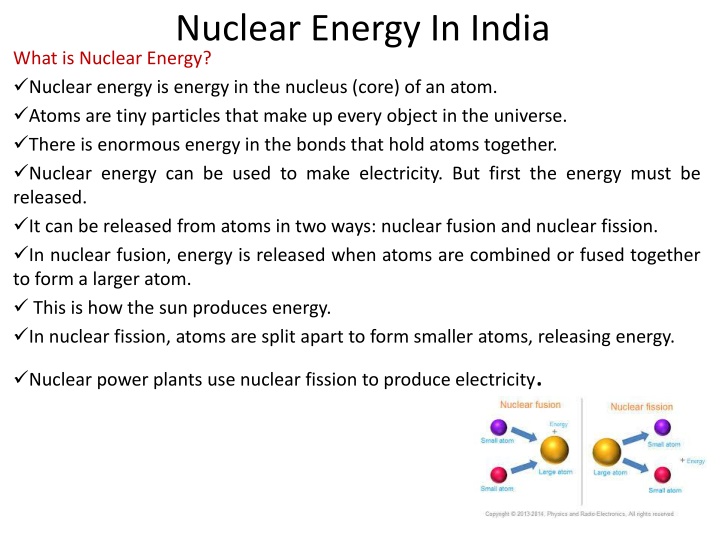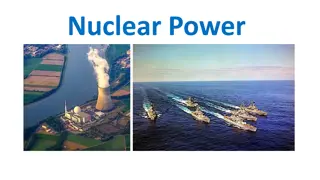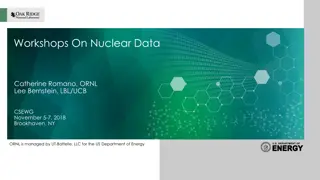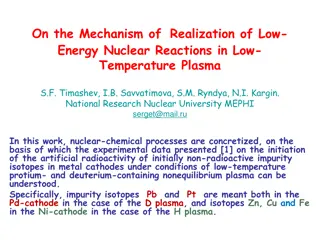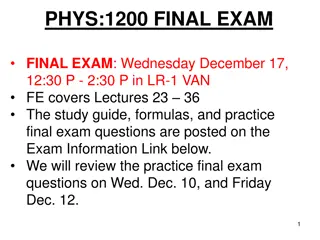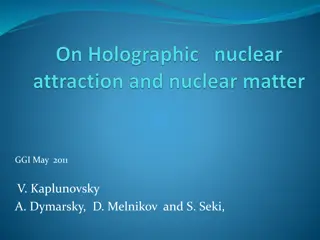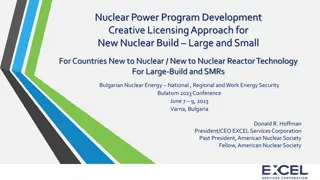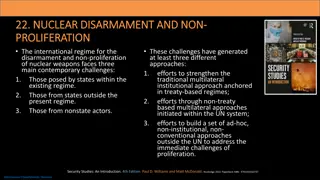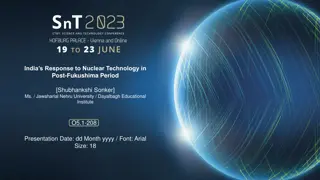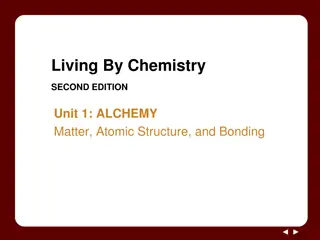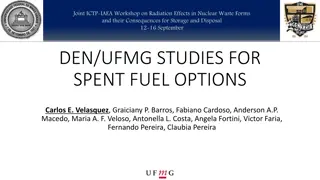Nuclear Energy in India
Nuclear energy, harnessed through nuclear fission and fusion, plays a significant role in India's power generation. Learn about nuclear reactors, raw materials, and the country's nuclear power plants. Discover the history of nuclear bomb testing in India, including Pokhran I and II.
Download Presentation

Please find below an Image/Link to download the presentation.
The content on the website is provided AS IS for your information and personal use only. It may not be sold, licensed, or shared on other websites without obtaining consent from the author.If you encounter any issues during the download, it is possible that the publisher has removed the file from their server.
You are allowed to download the files provided on this website for personal or commercial use, subject to the condition that they are used lawfully. All files are the property of their respective owners.
The content on the website is provided AS IS for your information and personal use only. It may not be sold, licensed, or shared on other websites without obtaining consent from the author.
E N D
Presentation Transcript
Nuclear Energy In India What is Nuclear Energy? Nuclear energy is energy in the nucleus (core) of an atom. Atoms are tiny particles that make up every object in the universe. There is enormous energy in the bonds that hold atoms together. Nuclear energy can be used to make electricity. But first the energy must be released. It can be released from atoms in two ways: nuclear fusion and nuclear fission. In nuclear fusion, energy is released when atoms are combined or fused together to form a larger atom. This is how the sun produces energy. In nuclear fission, atoms are split apart to form smaller atoms, releasing energy. Nuclear power plants use nuclear fission to produce electricity.
Raw Materials for Nuclear Plant Uranium ore - the principal raw material of nuclear fuel/ Thorium Nuclear power is used for two purposes(i) Constructive (Power Generation) (ii) Deconstructive (Nuclear Weapons) Nuclear Power in India India in 2015 produced 1383 TWh(Terawatt hours) of electricity, 1042 TWh (75%) of this from coal, 138 TWh (10%) from hydro, 68 TWh (5%) from natural gas, 48 TWh (3.5%) from solar and wind, 37 TWh (2.7%) from nuclear, 27 TWh from biofuels, and 23 TWh from oil.
What is a Nuclear Reactor? A nuclear reactor produces and controls the release of energy from splitting the atoms of certain elements. In a nuclear power reactor, the energy released is used as heat to make steam to generate electricity. Number of Nuclear plants in India Nuclear Power Corporation of India Limited- established in 1956 Name of the power station S.No State Operator Total capacity Tarapur Atomic Power Station 1. Maharashtra NPCIL 1,400 Kakrapar Atomic Power Station 2. Gujarat NPCIL 440
Kudankulam Nuclear Power Plant 3. Tamil Nadu NPCIL 2,000 Kaiga Nuclear Power Plant 4. Karnataka NPCIL 880 Madras Atomic Power Station 5. Tamil Nadu NPCIL 440 Rajasthan Atomic Power Station 6. Rajasthan NPCIL 1,180 Narora Atomic Power Station 7. Uttar Pradesh NPCIL 440
Nuclear Bomb Test India so far conducted two Nuclear Bomb Test Pokhran I and Pokhran II. Pokhran I was a single nuclear test conducted in 1974. Code name: Smiling Buddha : Indira Gandhi was the PM Pokhran II was a group of 2 nuclear tests conducted in 1998. Department of Atomic Energy was created in 1954,
